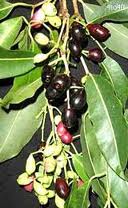http://www.sidhhaherbs.blogspot.com
Ficus Benghalensis
ஆலமரம்
The Banyan Tree at Fort Myers

A Banyan tree is a fig which has the ability to spread out laterally from the original by using aerial prop roots.
Old trees can cover a very large area. The largest are found in Kolkata in India.
The tree at Fort Myers Florida was planted by Thomas Alva Edison in 1925. It covers 400 feet and is the third largest in the world.
It is also known from the story of Robinson Crusoe, who in the novel by Daniel Defoe builds his home in a Banyan tree.
In our country Malaysia there were few seen at the Ipoh railway station and in Batu Caves K.L.
But alas most of them were cut down by our people!
It can be grown for shades in parks
Indian Banyan or Ficus benghalensisThe national tree of India.
Banyan is a very huge structure, long and deep roots and branches symbolize the country's unity. One can find banyan trees in throughout the nation. The huge sized tree acts as a shield, protects from hot sun. This is the reason why the tree is planted near homes, temples, villages and roadsides. In the rural parts of the country, banyan tree is considered as the focal point of the Panchayats and the gathering place for village councils and meetings.
The tree is also considered sacred by the Hindus of India. With high medicinal value, banyan is often used as a herb to treat and cure many diseases. Given below is the description of banyan, the national tree of India.
Importance In The Indian Culture
The tradition of worshipping 'sacred' trees is prevalent among the people following Hinduism, since ages.
Rig Veda and Atharva Veda stipulate that trees should be worshipped, for their inevitable role in human life. Banyan is considered one among the sacred trees.
In the Hindu mythology, Lord Shiva is sometimes depicted sitting in silence, under the banyan tree, with the saints sitting at His feet. With its seemingly unending expansion, the banyan tree symbolizes eternal life. In Hindu culture, the tree is often called 'kalpavriksha', a Sanskrit word, which means 'a divine tree that fulfills wishes'. Married Hindu women worship the banyan tree to lead a long and happy married life.
Features
Banyan tree is characterized by a tangle of branches, roots and trunks. The tree is deeply rooted, which may spread across several acres. It is huge in size, thereby giving protection from hot sun. The tree bears fruits that look like figs. The fruits, which appear red in color when matured, are not edible. The dark green leaves of the tree are large and leathery. This is the reason why, the leaves are used as animal fodder. The flowers produced by the tree often attract wasps, for pollination. An old banyan tree can reach more than 656 feet in diameter and can be as tall as 98 feet. The rubber, produced from the sticky milk of banyan tree, is used for gardening.
- The name 'banyan' is derived from Banias, who rested under the trees to discuss their strategies regarding business.
- The widest tree in the world - the Great Banyan - is located in Kolkata. The tree is about 250 years old.
- Historical records say that Alexander the Great camped under a banyan tree that was large enough to provide shelter to his army of 7000 men.
- In many parts of the world, the wood and bark of the banyan tree are used for making paper.
- People even make use of the roots of the tree to make ropes, in order to secure wood bundles.
- The sap produced by banyan tree is often used to produce shellac, a strong adhesive. It can also be used to make surface-finisher.
- Women in Nepal crush the root of the banyan tree with a paste to make a herbal product, which is used by them as a hair and skin conditioner.
- In India and Pakistan, the twigs of banyan tree are sold as toothpicks in order to promote dental health.
- Banyan tree is well known for its medicinal uses. Its sap is a medicine for treating external skin inflammations and bruising, dysentery, toothaches and ulcers. Its bark and seeds are used to produce a herbal tonic that can cool the body. Diabetic patients are also treated by the tonic made from banyan tree. Thanks to iloveindia
http://www.sidhhaherbs.blogspot.com

.jpg)
naval3.jpg)
naval.jpg)